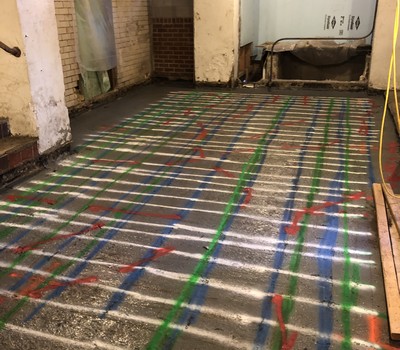Comprehensive Guide to Concrete Scanning Technologies
Comprehensive Guide to Concrete Scanning Technologies
Blog Article
Past the Surface Area: Leveraging Advanced Concrete Scanning Techniques for Unmatched Accuracy and Understanding
In the realm of building and construction and infrastructure maintenance, the quest for accuracy and thoroughness is never-ending. Advanced concrete scanning methods have become vital devices in this pursuit, supplying a glance underneath the surface area to unveil a world of essential understandings. By taking advantage of advanced technologies, professionals can uncover abnormalities, examine the condition of concrete frameworks, and make informed decisions that shape the course of tasks. The ramifications of these strategies prolong much beyond plain surface-level assessments, assuring a depth of precision and understanding that is unequaled.
Relevance of Advanced Concrete Scanning
The significance of using innovative concrete scanning techniques lies in the unmatched precision they provide for spotting sub-surface abnormalities and making certain architectural honesty. By using cutting-edge modern technologies such as ground-penetrating radar (GPR), electro-magnetic induction, and advanced sonar imaging, construction experts can dig underneath the surface area of concrete structures with a level of accuracy that much surpasses conventional assessment techniques. Concrete Scanning. These methods enable the recognition of surprise threats like rebar deterioration, gaps, channels, or post-tension wires that can endanger the security and safety and security of a framework in time
Moreover, progressed concrete scanning gives vital understandings right into the general condition of a concrete aspect without the need for invasive actions, minimizing the danger of causing damages throughout the assessment procedure. The capability to identify the specific location and depth of potential issues permits for targeted repair services and upkeep, ultimately lengthening the life-span of the structure and optimizing its efficiency. In significance, the relevance of sophisticated concrete scanning can not be overstated in the world of building and construction and facilities maintenance, where accuracy and integrity are vital.
Types of Cutting-Edge Technologies

Abnormalities and Flaw Discovery

Along with GPR, concrete scanning techniques like thermography and impact-echo testing are also efficient in detecting abnormalities and issues. Thermography makes use of infrared modern technology to identify variations in surface area temperature, suggesting prospective areas of issue such as delamination or wetness access. On the various other hand, impact-echo testing involves evaluating acoustic reactions to find spaces, fractures, and various other flaws within the concrete. By leveraging these sophisticated strategies, professionals can proactively address architectural concerns, ensuring the long life and safety and security of concrete frameworks.
Assessing Concrete Condition
Just how can designers accurately review the condition of concrete frameworks to guarantee their longevity and security? Various sophisticated concrete scanning strategies are employed for this function. Ground-penetrating radar (GPR) is generally used to examine the internal structure of concrete, detecting spaces, fractures, and various other anomalies that may from this source endanger its strength.
In addition, aesthetic inspection remains an essential component of concrete problem assessment. Engineers visually take a look at the surface area for signs of degeneration, such as spalling, fracturing, or discoloration. Combining non-destructive testing techniques with aesthetic inspections permits a detailed analysis of concrete problem, enabling engineers to determine prospective problems early on and implement timely maintenance or repair work. By leveraging these sophisticated methods, designers can make certain the long-term toughness and safety and security of concrete frameworks.
Enhancing Decision-Making Processes
In the world of facilities administration, optimizing decision-making processes is imperative for ensuring the reliable maintenance and longevity of concrete frameworks. Improved decision-making processes in concrete monitoring include utilizing go to this web-site innovative scanning methods to gather thorough data on the condition of frameworks. By leveraging innovations such as ground-penetrating radar and 3D imaging, stakeholders can make enlightened decisions regarding reinforcement, substitute, or repair methods.
These progressed scanning methods supply indispensable understandings into the inner composition of concrete, recognizing potential problems such as spaces, splits, or deterioration that might not show up on the surface. This degree of detailed info enables proactive maintenance preparation, reducing the threat of structural failures and boosting the total lifespan of concrete frameworks.
In addition, by including digital documents and evaluation devices into the decision-making process, stakeholders can track the evolution of concrete problems gradually, making it possible for anticipating upkeep techniques and maximizing source appropriation. Ultimately, the integration of advanced concrete scanning techniques enhances decision-making processes by providing unmatched accuracy, insight, and effectiveness in facilities administration.
Conclusion
Finally, advanced concrete scanning techniques provide unmatched precision and insight in identifying abnormalities, issues, and examining the condition of concrete structures. By leveraging innovative innovations, decision-making procedures can be improved, resulting in more informed and reliable services for maintaining and fixing concrete framework. These methods play a vital function in guaranteeing the safety and long life of concrete frameworks, making them an essential device in the area of building and engineering.
Furthermore, progressed concrete Full Article scanning gives important insights right into the general condition of a concrete component without the requirement for invasive procedures, lessening the risk of triggering damage during the assessment procedure - Concrete Scanning. Another cutting-edge technology is 3D X-ray scanning, which gives comprehensive photos of the interior structure of concrete, providing beneficial info without the need for harmful screening. Furthermore, Concrete Cover Meters are made use of to measure the density of concrete cover over reinforcement bars properly. Enhanced decision-making procedures in concrete management include making use of advanced scanning methods to collect comprehensive data on the condition of frameworks.In verdict, advanced concrete scanning methods supply unequaled precision and insight in identifying abnormalities, defects, and evaluating the problem of concrete frameworks
Report this page